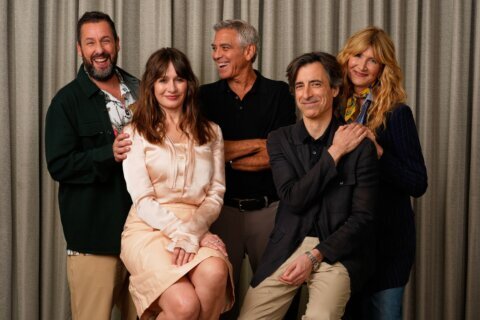WASHINGTON — They’re the most beloved and reviled figures in The Bible, a relationship of self-fulfilling prophecy sealed with an infamous kiss of betrayal.
Now, Jesus (Nicholas Edwards) and Judas (Ari McKay Wilford) collide in the latest rendition of the 1970 rock opera “Jesus Christ Superstar,” running until July 9 at Signature Theatre in Shirlington.
“It’s the greatest story ever told,” Wilford said. “One of the most iconic rock scores in musical history.”
Penned by Tim Rice (lyrics) and Andrew Lloyd Webber (music), the story follows Jesus of Nazareth during the last week of his life. It opens with Jesus and his disciples arriving in Jerusalem, continues with the struggles between he and his betrayer Judas Iscariot, and ends with his ultimate crucifixion.
“It’s unbelievable it was their first collaboration,” Edwards said. “He’s even said if he tried to write it today, he couldn’t. It probably wouldn’t have had the same response that it had back then. You listen to it today … it still feels like he wrote this a year ago and it still sounds as thrilling as it did back then.”
Most folks are familiar with the 1971 Broadway show, starring Jeff Fenholt as Jesus and Ben Vereen as Judas, or the 1973 Norman Jewison film, starring Ted Neeley as Jesus and Carl Anderson as Judas. But it was a more recent version that caught the eye and ear of Edwards as he discovered showtunes.
“I saw the 2000 [version] with Glenn Carter; that’s how I was introduced to it,” Edwards said. “I loved it! I immediately was like, ‘Holy crap, this music is amazing! Ridiculous, but amazing.’ Then, when I got this [part], that’s when I actually went back and listened to the [original], which was even better.”
Wilford did similar research in preparation for his part.
“I’ve never seen it on stage, but I did see the original movie a long, long time ago when I was young,” Wilford said. “We actually watched it recently, as well as watching ‘The Last Temptation of Christ.'”
Just like that 1988 film by Martin Scorsese, “Jesus Christ Superstar” provides an alternate take on a familiar tale. Rather than adhering strictly to the Gospels, the show takes certain creative license in its interpretation, including a unique spin by director Joe Calarco (“Gypsy”) for a modern audience.
“Our director didn’t really want us to portray these biblical characters,” Edwards said. “We’re trying to do a modern retelling of this story [and] strip away any notion of magic and really bring it back down to, ‘What if it was just him as a person today, as a man?’ He’s scared, he’s unsure of himself, there are points where he finally becomes the leader that everyone needs him to be, but then, once there’s a shadow of doubt within his followers, all hell breaks loose. … All heaven breaks loose!”
This approach also allows for a reinterpretation of Judas.
“I’m trying to bring as much humanity to the character as possible,” Wilford said. “He is sort of reviled throughout history. We say, ‘You Judas!’ It’s a bad term to put on somebody, because we know that he betrayed Jesus and he’s the cause of his death. But there’s a lot of ideas that what Judas did was not necessarily because he wanted to betray him, but because he was told to do it; was destined to do it.”
In this light, Wilford hopes to find sympathy for his antagonist.
“I think Judas really loved Jesus and followed his teachings,” Wilford said. “In our story, he sees Jesus getting away from his original teachings and going toward more of this celebrity that he’s becoming. He doesn’t like that — and that’s what changes his mind. He sees it as a way for people to latch onto him for the wrong reasons. So I think Judas has good in his heart, but he’s set on the wrong path.”
How is this struggle expressed visually?
“The actors create The Last Supper using their bodies and pieces of the set that move, come together, and pull apart,” Edwards said. “You enter this space that’s timeless. It could be a church, it could be a normal place of worship, whatever you want it to be. … It’s very stripped away, but at the same time, there’s so much spectacle. … The lighting is divine. The set is gorgeous. It’s very seamless, it’s so sleek.”
Within this space, don’t expect any spoken dialogue. Every word is sung, a byproduct of the show’s recorded roots, as many people forget that the musical actually began as a rock-opera concept album.
“It wasn’t even supposed to be a show,” Edwards said. “They originally were pitching it to producers and everybody thought they were crazy. They were like, ‘I guess we’re just going to have to produce an album because people will at least listen to it,’ and it became this huge hit. People knew the music before they even got to the show, which was a big selling point. … It’s kind of like ‘Hamilton’ now.”
The Tony-nominated score is probably echoing through your head right now, featuring such iconic musical numbers as “What’s the Buzz,” “I Don’t Know How to Love Him” and “Everything’s Alright.”
“‘The Temple’ is my favorite, just because the rhythm is so interesting,” Edwards said, humming the tune. “Then definitely ‘Heaven on Their Minds,’ that is like the signature song. Even before I saw the movie, I had heard it before, but I didn’t know what it was from. I just remember the [lyric], ‘Jesus!'”
“I grew up listening to the music,” Wilford said. “I remember when I was 16 in my car trying to sing along with ‘Heaven on Their Minds’ on the original album. … I’ve done it so much now that I probably have to say that it’s not my favorite song in the show, although I still love it. I really like ‘Damned for All Time’ personally for me [to sing], and then as a song as I get to watch [Jesus sing]: ‘Gethsemane.'”
“Really?” Edwards said. “I am surprised. I thought you would pick something else. I feel flattered.”
“Love you, boo,” Wilford said.
And just like that, Signature Theatre is finding peace between Judas and Jesus, one show at a time.
Click here for more information. Listen to the full chat with Nicholas Edwards and Ari McKay Wilford below:







